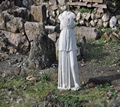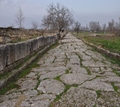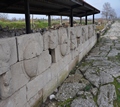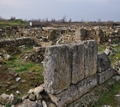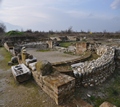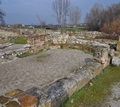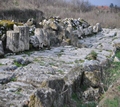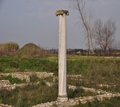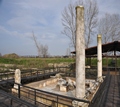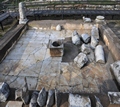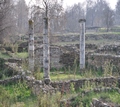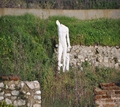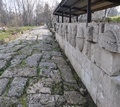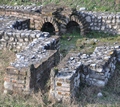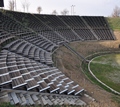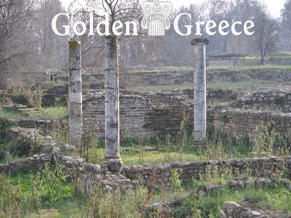
The archaeological site of Dion is located on the north-eastern slopes of Mount Olympus and at a distance of only 5 kilometers from the coast. The ancient Dion, "the city of Zeus", the sacred city of the ancient Macedonians, even if today it is in ruins, conveys to the visitor admiration.
In the archaeological park one can walk among the findings and visit the adjacent archaeological museum.
From the excavation findings, it appears that Dion covers an uninterrupted life of 1000 years, from the 5th c. BC until the 5th c. A.D.
From the testimonies of ancient authors we are informed that the Macedonians gathered in Dion, to honor the Olympian gods with sacrifices and offerings at regular intervals. Thousands of Macedonians flocked to this place to celebrate the "en Dio Olympia", which was held with particular splendor from the 5th century BC.
Also the area was connected with the death and burial of Orpheus.
Here the king Archelaos (414-399 BC) at the end of the 5th c. BC established athletic and stage competitions in honor of Zeus and the Muses which lasted nine days.
Philip celebrated at Dion glorious victories, and Alexander, setting out on the great campaign in Asia, sacrificed to Olympias Zeus. In the sanctuary of Olympian Zeus, the famous bronze regiment of Lysippus was erected, representing the 25 horsemen who fell in the battle of Granikos.
In the years of Philip V after a devastating invasion, the Aetoli razed the city. In the battle of Pydna in 168 BC. the death of the last Macedonian king Perseus marked the dissolution of the Macedonian kingdom. Dion became a Roman colony in the Augustan years and was named Colonia Julia Augusta Diensis. The second heyday of the city occurs in the Roman years, in the 2nd and 3rd centuries. AD, when Dion experiences a Greek renaissance.
In early Christian times the city shrank.
The epilogue is written for Dion in the 5th century. AD, when devastating earthquakes, floods and other disasters mean the end of the city. Its inhabitants leave it in fear and climb to the low heights of Olympus seeking safety.
The holy city of the Macedonians crumbles into ruins covered under the soil of the Macedonian land.
The impeccably laid out city was surrounded by a square fortified enclosure of the 4th c. BC (early Hellenistic years) while a dense network of roads crossed it. Excavations revealed building blocks with residences, workshops, shops and public buildings.
From the cluster of sacred buildings stand out: the sanctuary of the Most High Zeus, which was surrounded by smaller sanctuaries and altars where the rest of the Olympian gods were worshiped (Artemis, Dionysus, Athena, Hermes, Vauvo).
Impressive and of great extent is the mosque with the sanctuary of Demeter, which was surrounded by a high enclosure, so that the sacraments performed would not be desecrated.
Also, during the excavations, two temples dating back to around 500 BC were revealed, the sanctuary of Asclepius and Health and the entire mosque of Isis, demolished by an earthquake but untouched, with the cult statues standing on their bases.
Also in Dion, the Muses were worshiped as well as Aphrodite Hypolympidia, the goddess of the foothills of Olympus.
The Hellenistic theater, a building of the 4th century, where the tragedies of Euripides were staged, is today preserved in fragments, as only part of the hollow and the stage can barely be distinguished have been revealed after excavation.
The theater of Roman times, which was built when the Hellenistic ceased to be used in the 2nd century AD. It consists of a horseshoe-shaped orchestra surrounded by a hollow, which was supported by vaulted wedge-shaped spaces. The building of the tent, the foundations of which are preserved, was not connected to the hollow.
Worthy of attention is the so-called "Palace of Dionysus", with marvelous mosaics, the Roman public baths, which occupied four acres, the monument of the Shields, the four underground vaulted Macedonian tombs in the extensive necropolis of the ancient city and many other finds that await the visitor on a pilgrimage to antiquity.
Editor: Fotini Anastasopoulou











